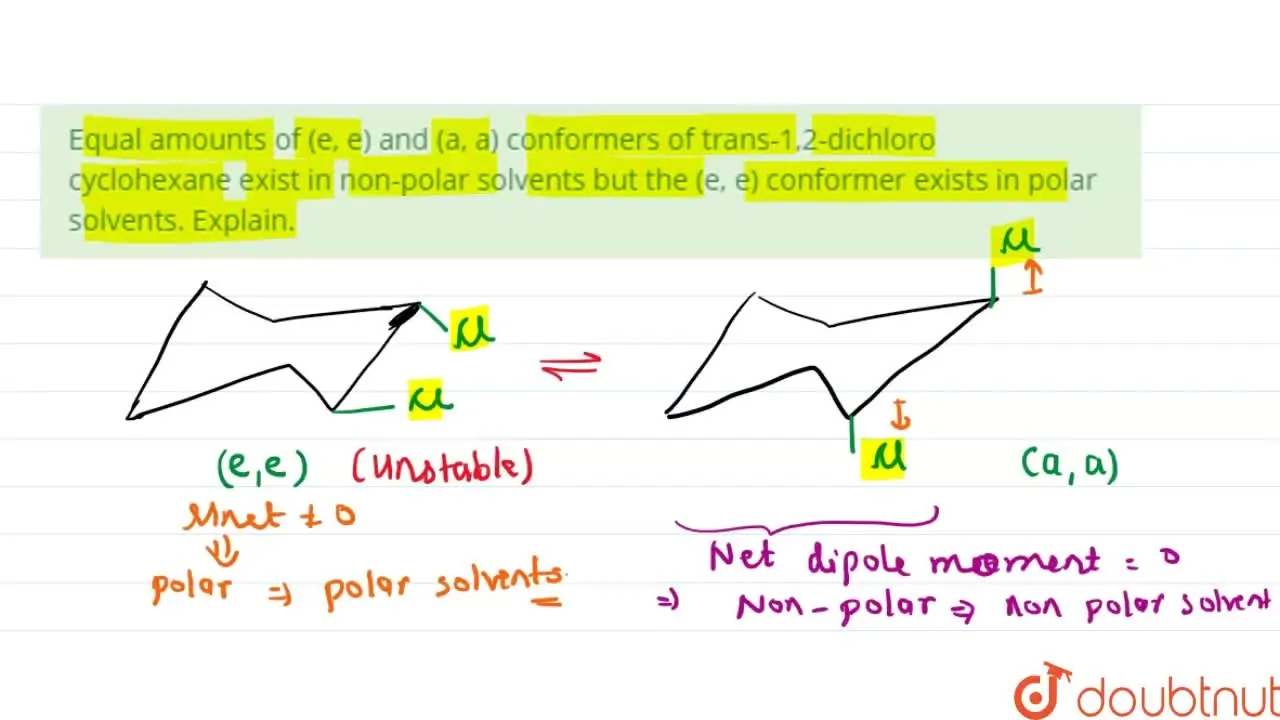Equal amounts of (e, e) and (a, a) conformers of trans-1,2-dichloro cyclohexane exist in non-polar solvents but the (e, e) conformer exists in polar solvents. Explain.
(I) 
In (I), there is dipole-dipole repulsion between two equation C1 atoms. It partially destabilises the sterically more fovoured (e, e) conformed bot not the (a, a) conformed (II) where C1 atoms are further apart. Therefore, the conformers (I) and (II) coxist together because their energies are very close. But the polar solvent molecules surround the C1 atoms by dipole-dipole attraction and relieve the dipole-dipole repulsion between C atoms themselves. Hence, the lower energy (e, e) conformation (I) perdominates in polar solvents.
Related Playlists
- BOOK - CENGAGE CHEMISTRY ENGLISHCHAPTER - ALKANES AND CYCLOALKANESEXERCISE - Paragraph for problem24videos
ALKANES AND CYCLOALKANES
- BOOK - CENGAGE CHEMISTRY ENGLISHCHAPTER - ALKANES AND CYCLOALKANESEXERCISE - True and False1videos
ALKANES AND CYCLOALKANES
- BOOK - CENGAGE CHEMISTRY ENGLISHCHAPTER - ALKANES AND CYCLOALKANESEXERCISE - SOLVED EXAMPLES19videos
ALKANES AND CYCLOALKANES
- BOOK - CENGAGE CHEMISTRY ENGLISHCHAPTER - ALKENES AND ALKADIENESEXERCISE - Single correct Answer14videos
ALKENES AND ALKADIENES
Similar Questions
Explain why the covalent solids are usually soluble in non-polar solvents but are insoluble in polar solvents.
View Solution1,2-Dimethylcyclohexene undergoes only trans-addition with HBr
in non-polar solvents but both cis-and trans-additions
occur with aq. Acid. Explain.View SolutionPredict the product of reaciton for aniline with bromine in non-polar solvent such as CS2
View SolutionStatement-1 : CS2 behave as a non-polar solvent
and
Statement-2 : The shape of CS2 is linear .View SolutionAll the three i.e., water, ice and vapour exist simulatneously at
View SolutionAluminium chloride exists as a dimer, Al2Cl6 in solid state as well as in solution of non-polar solvents such as benzene. When dissolved in water, it gives :
View SolutionSTATEMENT-1 : lodine is more soluble in Cl(4) than in water.
and
STATEMENT-2 : Non-polar solutes are more soluble in non-polar solventsView SolutionWhat is the correct order of decreasing nucleophilicity in non-polar solvents: OH−,NH−2,F−,CH−3
View SolutionWhich of the following molecules have non zero dipole moments ?
(I) gauche conformation of 1, 2-dibromoethane
(II) anti conformation of 1, 2-dibromoethane
(III) trans-1, 4-dibromocyclohexane
(IV) cis-1, 4-dibromocyclohexane
(V) tetrabromomethane
(VI) 1, 1-dibromocyclohexaneView SolutionThe attractive forces that exist between non polar molecules such as O2,N2 or mono-atomic gases like He, Ne are called
View Solution


